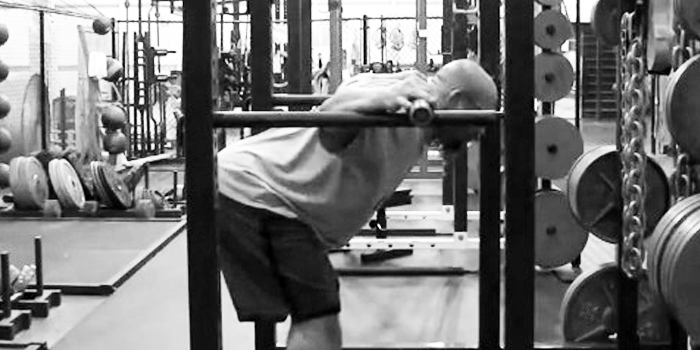
The Good Morning exercise has direct applications for the powerlifter looking to increase poundage. This exercise efficiently recruits posterior chain musculature and is therefor superb for developing thickness in many of the muscles you can not observe in the mirror. During the movement, the load strengthens the hamstrings and glutes, which can directly carry over into a stronger deadlift and squat. Erector spinae musculature is also heavily recruited in order to maintain back extension and provide stabilization. This can help with maintaining optimal posture during powerlifting movements. The movement trains the hip hinge, and can aid in higher power output, muscle firing timing, and overall movement mechanics.
A compilation of movement variations is found below. Variations are beneficial because they can change the focus of the improvement a lifter is striving to make. Variations include banded good mornings, safety squat bar good mornings, yoke bar good mornings, and many more. Be sure to try them all!
Seated Good Mornings with Bands and SS Yoke Bar
Good mornings are an essential back strengthening accessory for any lifter, from novice to advanced. The cool thing about Good Mornings is that there are many different variations and progressions.
For the novice lifter, for example, the movement can start by standing on a band and wrapping the other end around the shoulders. When the lifter becomes more advanced, you can add different bars and overload with a good amount of weight.
In this video, Clint Darden performs a seated good morning on a box squat box using an elitefts SS Yoke Bar against orange resistance bands to provide some accommodating resistance. Since Clint is seated, there is more focus on his quadratus lumborum (QL) and spinal erectors. Therefore, applying bands as accommodating resistance is a safe yet effective way to overload his back.
SS Yoke Bar Upper Back Good Morning with Mini-Bands
Matt Ladewski uses an elitefts SS Yoke Bar with Pro Mini Red Resistance Bands attached to a glute ham raise to strengthen his middle/upper back.
Having a strong middle and upper back is crucial, especially to help you in your big lifts. The squat, bench press, dead lift, and other lifts require strength in the middle/upper traps, rhomboids, rear delts, and lats. You will feel your back during the squat working by "breaking the bar over your back", a cue that coaches like to give their athletes in order to activate the lats.
Matt uses elitefts pro mini resistance bands (red), hooking them up to the elitefts glute ham raise. and attaching them around the elitefts SS Yoke Bar for added resistance. He leans against the glute ham raise to take his lower back out of the exercise in order to target the mid/upper back.
From Dave's Training Log about this exercise:
This is not a beginner exercise. This is about working the muscles and not just doing the motion. If you can't feel or know how to contract this will be worthless for you.
Rackable Cambered Bar Good Mornings with Chains
Matt Ladewski, owner of Region Barbell Club, demonstrates how to perform good mornings on the elitefts rackable cambered squat bar with chains.
Preparation:
- Position barbell on the upper back and grasp bar to sides.
Execution:
- The hips extend backward with the glutes flaring and starting the movement.
- As the body hinges backward, the torso will lean forward. The entire spine is in a reinforced neutral position with a moderate arch in the lumbar. The core should be on “lock-down.” The chest is expanded with “big air belly” breathing in effect.
- As the hips reach their maximal point of extension, the glutes and hamstrings should be maximally recruited. Notice the upper back posture is still maintained and there is no collapse or loss of tension anywhere in the body.
- The gluteal muscles contract to bring the hips forward and return the body to a standing position. Again, there is no degradation of tension at any time.
Elitefts™ SS Yoke Bar Upper Back Good Morning (Spinal Erectors)
elitefts Founder and CEO Dave Tate explains the SS Yoke Bar upper back good mornings, which primarily targets the upper spinal erectors, as performed by elitefts advisor and mastermind of Mountain Dog Training John Meadows.
The lifter starts in a neutral spinal position, and maintains this position through the movement (focusing on keeping the hips locked in place). The upper back is rounded in a controlled fashion into a deep forward stretch, held in the stretch position for at least two seconds, and then slowly reversed to the starting position by arching, with maintaining tightness and attempting to drive the head rearward into the traps the main focuses. A strong contraction in the upper back should be the goal at this point. This exercise is a slow, controlled movement that focuses on the stretch and contraction and should not be rushed. See the video for detailed real-time coaching cues.
It is advisable to keep sets at least one or two reps short of failure to minimize stress on the lower back. This exercise is also a great way to hit the upper back while minimizing strain on the shoulders and biceps tendons.
The exercise can be done for reps, or for time, as Dave and John did during their most recent training session.
From Dave Tate's Training Log:
This is not a beginner exercise. This is about working the muscles and not just doing the motion. If you can't feel or know how to contract this will be worthless for you.
Deadlifts, Chains, and Good Mornings
Guys,
I'm having trouble with my deadlift. I'm new to powerlifting-style training, as I've been an NPC level bodybuilder for three years prior to 2012. I can rack pull 545 pounds easy and fast, but my deadlift has been stuck at 455 pounds for about six months. I struggle sitting back on the set-up. (The see-saw/power off the floor). Any advice? I primarily follow 5/3/1, Westside, or my personal programming.
- Justin
Hey Justin,
Okay, first of all, I think that you have to pick a program and stick with it. But since I'm not sure how you're training, I'll give you some ideas on how to fix this with both 5/3/1 and with Westside.
Since you can rack pull well and are slow off the floor, I'm going to say that to make an improvement we need to:
- Put you at a mechanical disadvantage—like a deficit.
- Teach you to become a faster puller—via pulling against bands and chains.
- Really work on some leg drive and lower back strength.
So, if your MAIN FOCUS is to improve your deadlift WITH 5-3-1, I would make the following changes:
Squat day
- 5/3/1 percentages using the safety squat bar, close stance
- 5x5 vogelpohl pulls (The one where you deadlift a bar conventional with a safety squat bar loaded on your back)
- Finish with your assistance work and abs for weaknesses—there had better be reverse hypers in there! Sets of 30 will blow up your deadlift.
Deadlift day
- 5/3/1 percentages pulling off a deficit—stand on a plate or a bumper plate.
- 8x2x50 @ 70% speed pulls (opposite stance of your normal pulls). Complete these from a one-inch deficit (aka: one mat).
- Move on to your assistance and abs.
However, If your are using a Westside template, I would do the following:
ME Lower Days
- Week One: A deadlift variation from a deficit—against bands, chains, or straight weight.
- Week Two: A front squat, back squat, or zercher variation—all close stance.
- Week Three: A safety squat bar squat or GM variation—all close stance (box squat, pause squat, reps, against chain, against band, etc.).
- After this, I would move into some close-stance leg presses against bands—this will build up your leg drive.
- Finally, pick the assistance you need.
DE lower days
- 9x2xDE squat—I would use safety squat bar variations and either squat to a box (set at the height of your hips during the deadlift) or no box (and pause in the hole). I prefer the second option because it will really help your squat, too. You can also wave DE front squats in the same way. Both should help your deadlift.
- 10x1 or 8x2 speed pulls—always from a deficit ranging from one to three inches. Go in your conventional stance and pull against straight weight, bands, and/or chains.
- Move onto your assistance work.
Anyways, let me know if that helps or if you need more help—in which case I'm happy to. Just send in a video so that we can really pick apart your weaknesses.
My deadlift stinks off the floor, too.
In your raw meet prep from Programs That Work 2, you say that you squat INTO chains at certain heights. I was curious how you set that up? Do you just adjust the lead chain so that it starts adding weight at those certain heights?
Thank you,
-Albert
Hey Albert,
So, I attach the chain to the top of the squat rack and squat down until I hit a point in my squat where the bar hits the chain. (Or sometimes I used safety straps—it just depended on what was lying around).
Let me know if that helps! And ALWAYS set at parallel or below!
What would you say is more effective for strengthening the lower back: standing BB good mornings or back extensions?
Hey Brian,
If your hamstrings are very strong, I'd probably say the back extensions. I'll give you an example as to why. For me, my lower back is weak compared to my hamstrings. Thus, when I do a good morning, I end up shifting back and putting all the weight in my hammys—not allowing me to get my back stronger. (See video below).
So, for me, I get more from back extensions—preferably with a barbell on my back. (Or a safety squat bar. That will really blow up your lower back). Also, since your hammys are taken out of it, seated good mornings are a really good way to build lower back strength. Especially with a safety squat bar, but regular bars work, too. And don't forget, if you have a reverse hyper, something like 5x30 with a foam roller between your legs (to activate your adductors) will really get your back strong.
Get on it. I hear the way to a girl's heart is a HOOOGE set of erectors!
Suspended Good Morning
Good mornings are famous for their awesomeness. Few exercises not called the deadlift can work your glutes, hams, and lower back like a good morning can. Suspended from chains, the eccentric portion is removed from the lift. Using chains like this is a great way to learn how to explode from the bottom of the lift.
Yoke Bar Suspended Good Morning
Matt Wenning talking about the suspended good morning.
Yoke Bar Good Morning
Dave talks Yoke Bar Good Mornings with Ted.
Exercise Index
Elitefts™ Collegiate Box Squat Box
Elitefts™ GHR-Glute Hame Raise
Elitefts™ Pair of 5/8th Chains









